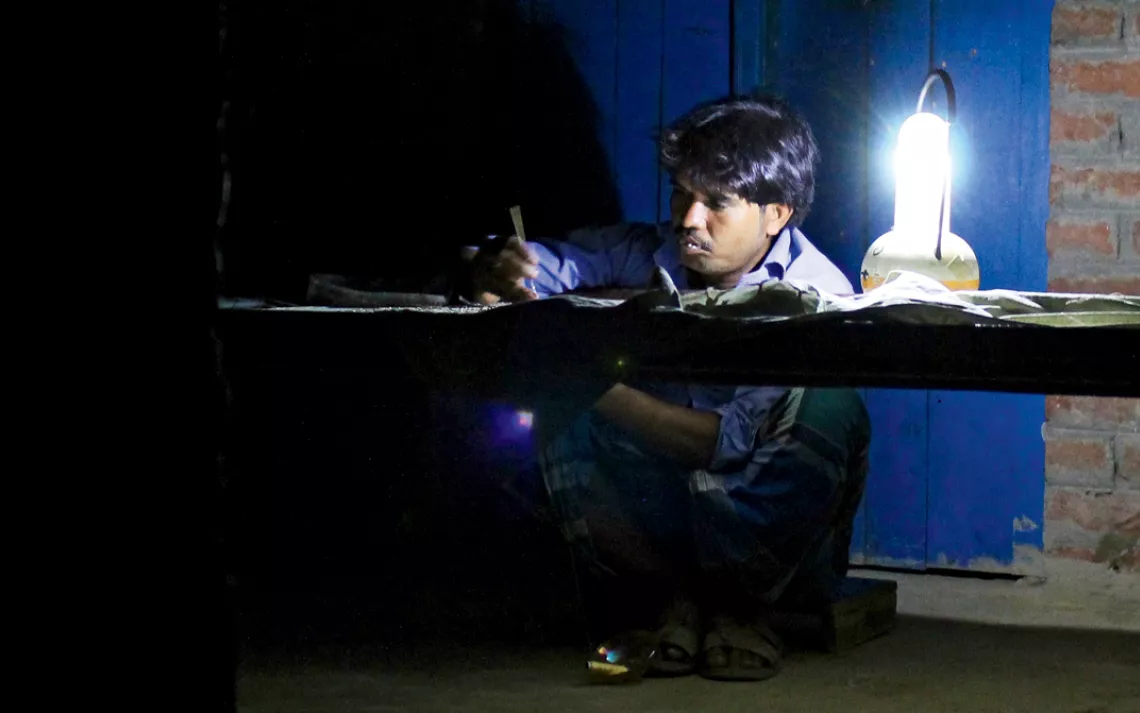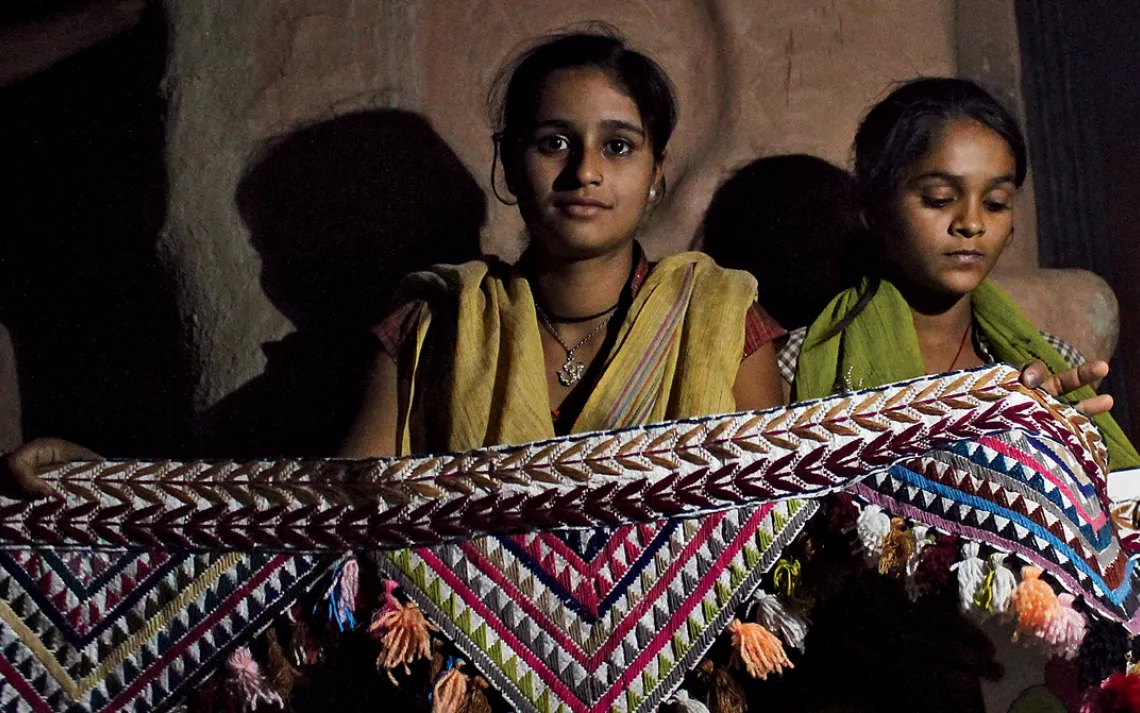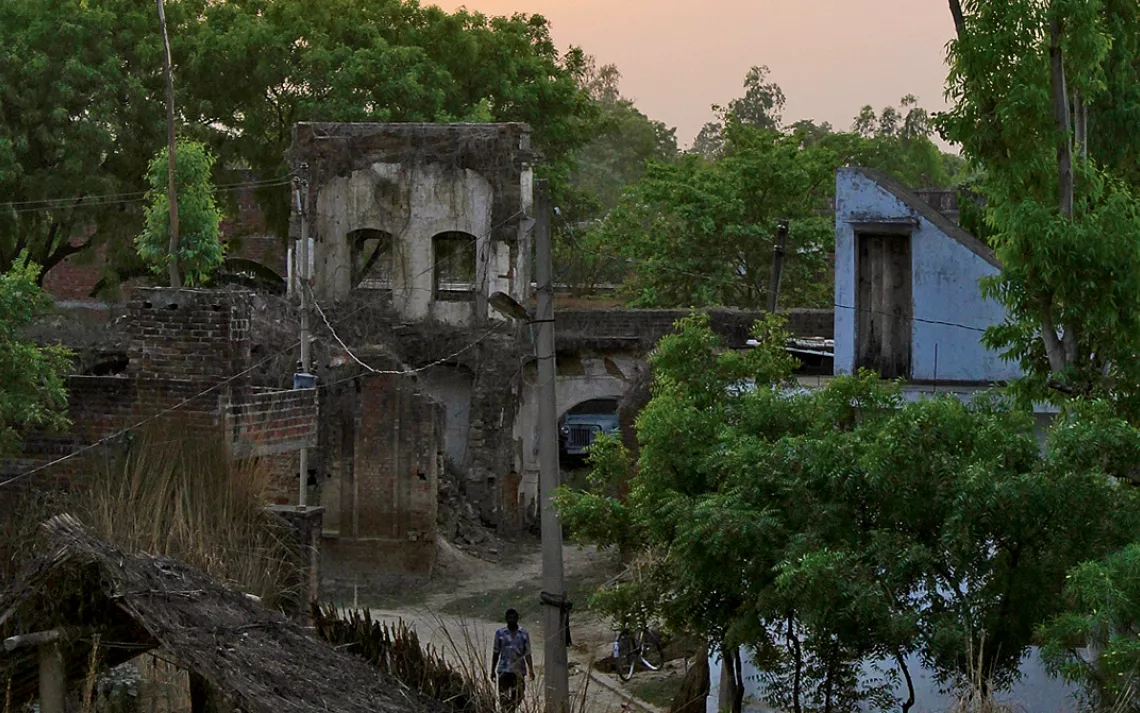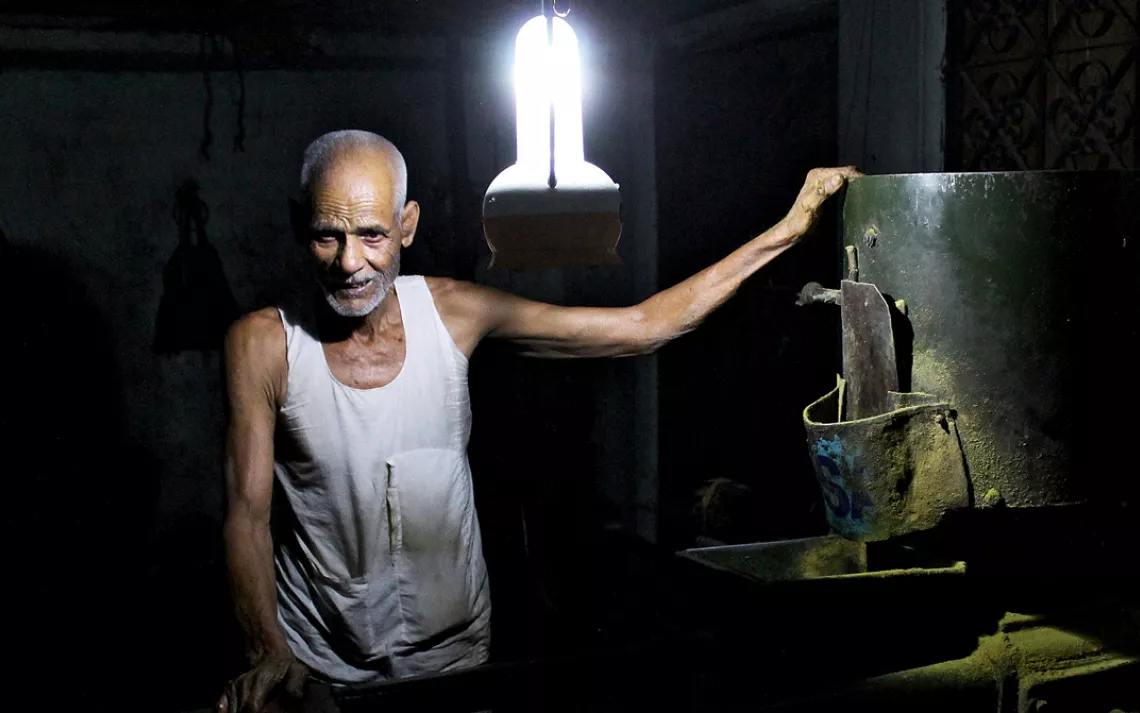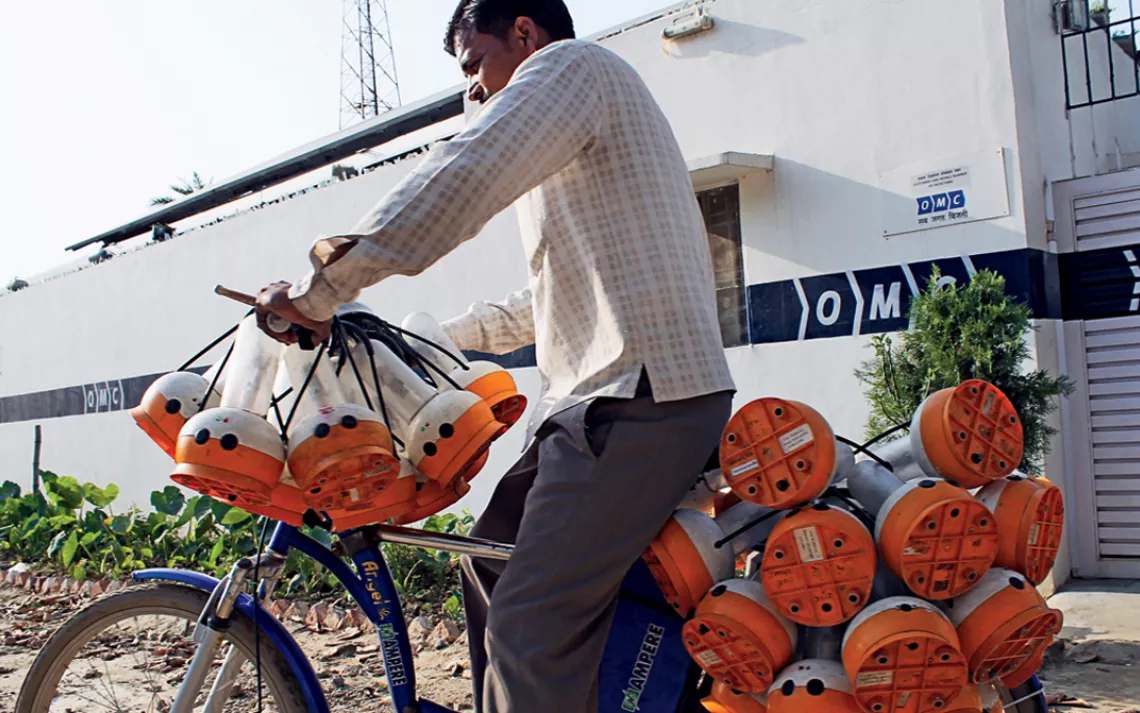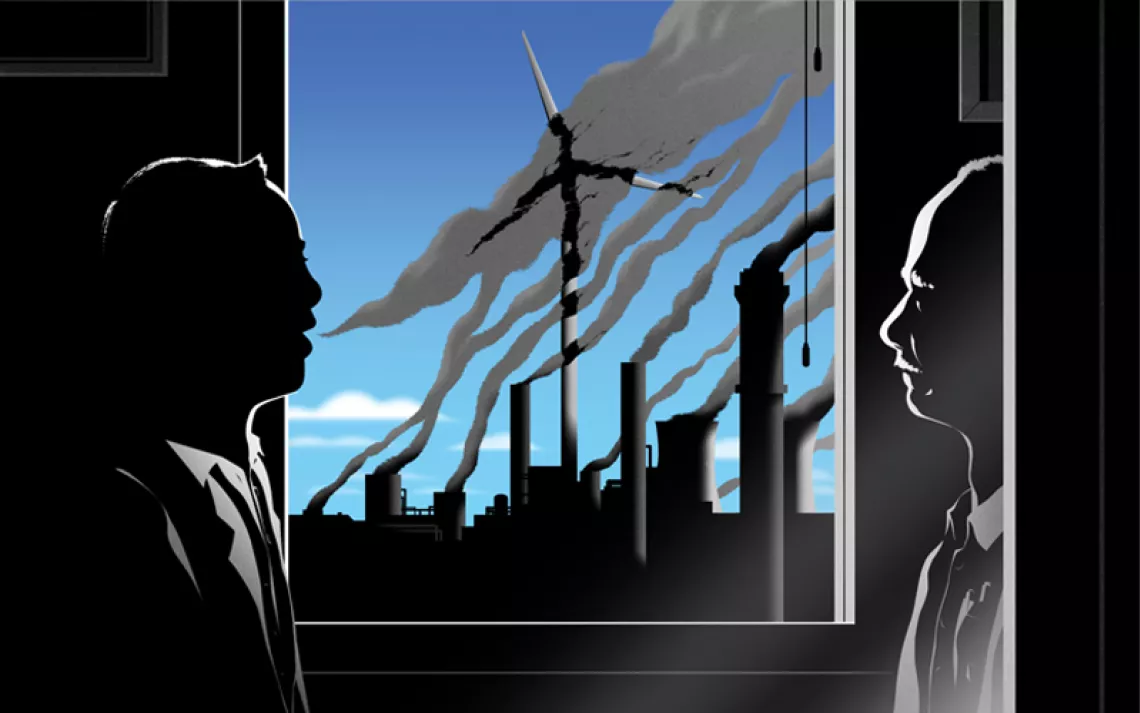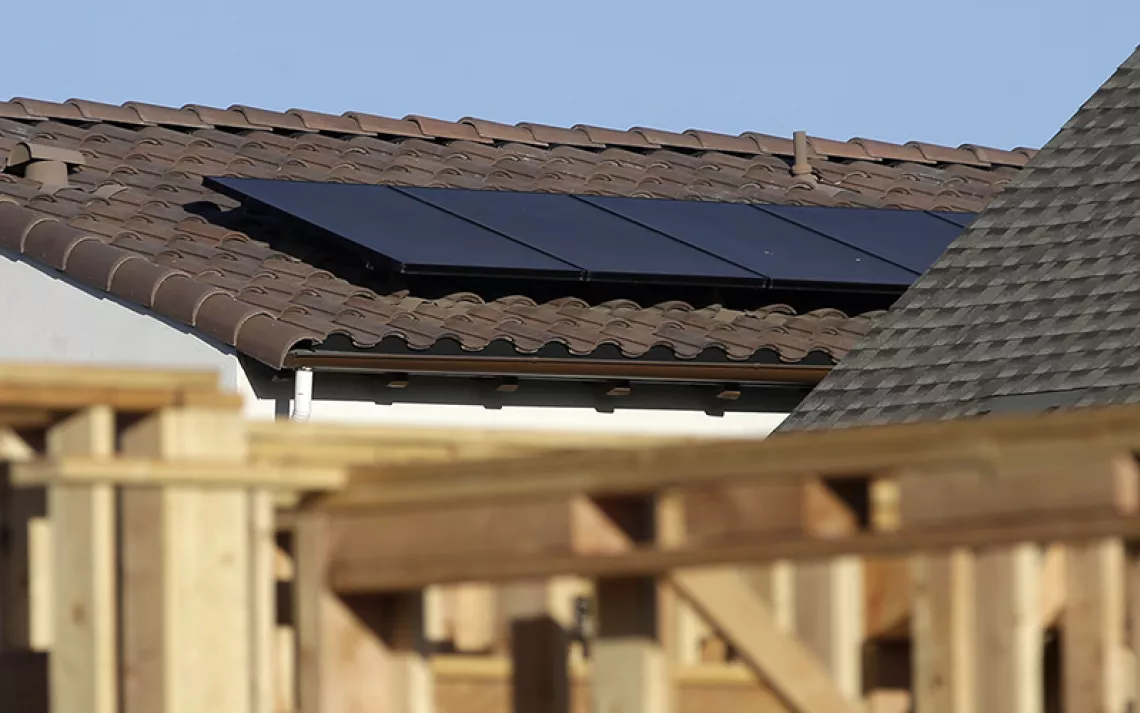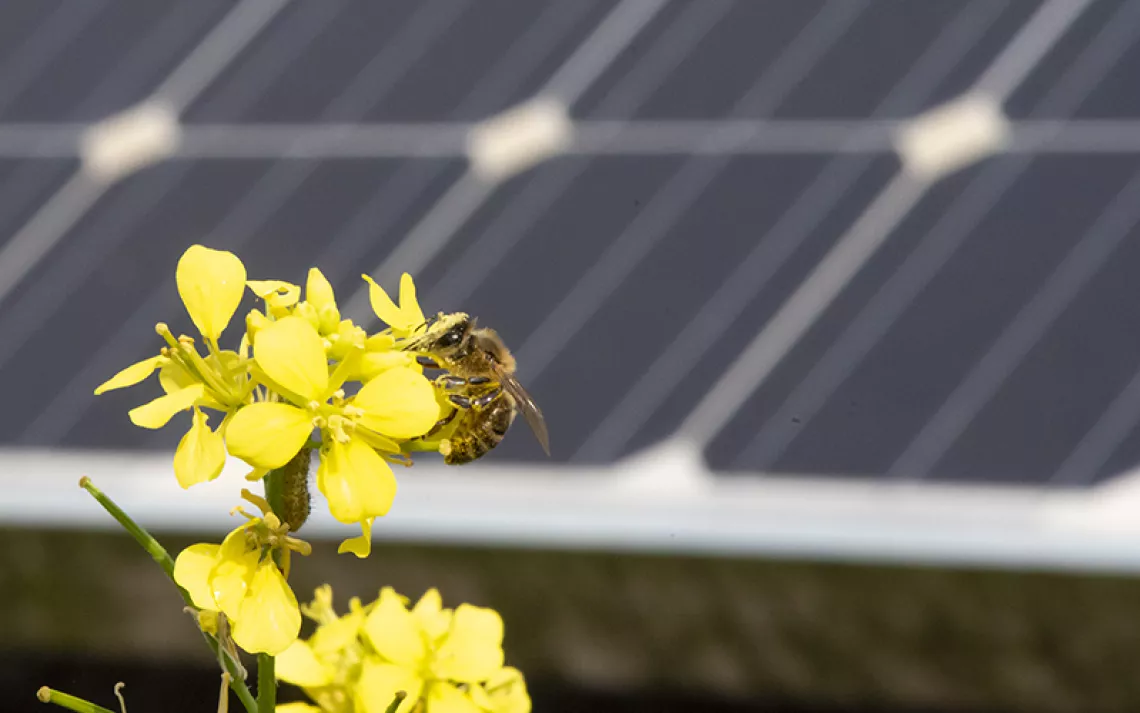Waiting for Light
Will off-grid solar fix India's energy problem?
The sky above northeast India looked like mango skin. It was late afternoon in May, and across a constellation of villages, deliverymen worked to unload their solar-charged lanterns from trucks and bicycles before nightfall. They leaned into dung-and-straw huts, calling, "Lantern, lantern." They passed the devices to women in colorful saris, to bucktoothed kids, to men in sweat-stained undershirts, lingering while the customer made sure the lantern worked, head angled and skeptical.
As the sky dimmed, the lanterns were hung from the ceiling of every shop, precise white spheres in the darkness. A mustard grinder ran his seeds through his diesel-powered machine. A bangle maker massaged heat into metal until the smell of malleability crept out. Children did homework. Women cooked dal. All were warmed by the day's trapped energy diffusing from the mud bricks. The next morning, the deliverymen would retrieve the lanterns and whisk them back to solar-powered plants to be recharged during the day.
The rechargeable LED lanterns came in 2012, by way of Delhi-based solar energy concern Omnigrid Micropower Company (OMC), which leases them to about 36,000 customers across the state of Uttar Pradesh for $2.50 a month. When the company first set up shop, its primary focus was using solar plants to power telecom towers, which once depended on diesel generators. But that changed quickly. "As we looked at it closer, we realized the power demand would be larger for the community than for telecom," said Pär Almqvist, OMC's chief marketing officer. In addition to the lanterns, the company offers battery boxes that power fans and cellphones, and it will soon become the first Internet service provider in the area. But right now, OMC's mission is all about light: Put photons where there are none.
The market for OMC and its two dozen peer companies is huge. Roughly 400 million of India's 1.2 billion inhabitants lack access to electricity--more than the combined populations of the United States and Canada. Indians without electricity typically use kerosene wick lights, which cause eye and respiratory disease, start fires, rely on sporadically available fuel, and provide about the same amount of illumination as a birthday candle.
That May night, I rode out of a village called Jangaon and into the hills. As Jangaon receded, its 800 lanterns blended in with the stars, and I saw in our headlights that the road was disappearing too. It was just whorls in sand now. I caught a passing glimpse of the pearly, vacant eyes of a buffalo. Then the brick wall of a tiny village appeared. This was Aat, an unlighted hamlet hidden amid mango orchards.
"This is the darkest place I have seen in my life," proclaimed the man sitting beside me in the backseat. He was Ritu Raj Verma, OMC's boss in the field, head of rollout, a person with an almost religious need to distribute light.
The car stopped, and Verma told the driver to cut the headlights. The prominent dichotomy in Verma's life was of light and dark, and he was determined that I see which prevailed here. "You see? Full dark," he said. "I will make this village glow like a sun. I will bring them the light." I couldn't see his face, but I saw his broad head, with a dollop of hair on its crown, silhouetted by the stars and moon out the window behind him.
Over the wall lived the family of Ramswarup Verma (no relation to Ritu Raj), a farmer of 40 with the grooved, leathery face of someone much older. He wakes and sleeps by the rise and fall of the sun, which isn't as romantic as it sounds. When night arrives and Aat gets dark, the Verma family goes to bed for lack of anything else to do.
Mr. Ramswarup, as he preferred to be called, didn't expect the electrical grid to reach Aat in his lifetime. "There are many larger villages. We only have four to five houses," he told me the next night, when I visited him with a translator. His biggest complaint about the darkness was that he couldn't visit the water pump at night. Without a light, he couldn't see the snakes.
"With a lantern I will go to the market, my children will study, I will get water from the ground," he said. "If I get the light, it will change my life."
We were on a dirt patio of sorts for his goats and buffalo, inside the brick wall but outside his house. We sipped chai. And just as I was viewing Aat through the prism of America, he was doing the reverse.
"How is there electricity 24 hours in the United States?" he asked me.
"Are there mosquitoes and flies in America?"
"Do you have mangoes?"
"Is there a dowry system?"
My translator, Manoj, asked if it was true that France is the only country without mosquitoes. I didn't know the answer.
Then the two of them were talking in Hindi, and Manoj was making a fist with his left hand and shining a flashlight on it with his right hand, slowly rotating the fist. "He is asking how when it is night in India, it is day in the United States."
I pointed to the night sky and said, "Did you know that a human has walked on the moon?"
Mr. Ramswarup shook his head, his expression unchanging. He didn't seem to care.
"Do you believe me?" I asked.
"Yes."
"What are the moon and stars to you?"
"They are the gods."
We drove away over the bumpy dirt road, which is impassable by OMC's bicycles and delivery trucks. The company is creating a program to deliver solar-charged batteries by motorbike. Later this year, Mr. Ramswarup will lease a lantern that he can keep in his house and repower daily with a newly delivered battery.
For Indians who live in darkness, electricity has long been a mirage resolving just beyond the gridded horizon. In villages throughout the country, utility poles lean and split. Some hold wires, put up by the government decades ago and then abandoned; others were erected by well-to-do individuals who hoped the sight of grid pillars would compel a state body to string wires across them. The poles are a reminder of the dying notion that the only thing separating people from power is a few dozen miles of copper wire.
In fact, one obstacle to full electrification in India might be the institutional faith in the grid itself (or grids--there are four), which fails the consumers who are connected to it. India's grid routinely suffers 30 to 40 percent power loss between the source and end user, mostly from pilferage and technical inefficiencies, and the grid runs largely on coal.
The most promising avenue for powering up India's rural poor could lie with private companies like OMC, offering solar-powered light via lanterns, household panels, or tiny, self-contained grids. There are 15 to 20 such companies, plus dozens more hyper-local providers, something like the neighborhood barbershops of solar installment. As easily as OMC distributes a truckload of lanterns, another start-up can wire a few dozen buildings to a mini-solar plant (called a mini-grid) or install solar panels on a single rooftop. The different delivery methods have their own pros and cons, but one of off-grid solar's greatest advantages is the ease with which companies can tailor their offerings. In a likely scenario, companies would offer combinations of prepackaged lighting, mini-grids, and rooftop solar panels.
A successful private sector industry wouldn't only power up new consumers using renewables; it would also severely undermine any chance that these people would use dirty power down the road.
"We'll be building an entirely different system from the bottom up," said Justin Guay, associate director of the Sierra Club's International Climate Program.
When all is said and done, one of the coal industry's favorite narratives--that its ability to provide cheap power to people in need outweighs its nefarious effects--would be cut down by a counterargument that's 400 million strong.
But the industry needs help from India's government. Like start-ups in San Francisco and New York, many off-grid companies in India go belly-up before they can get on their feet. "A lot of the companies understand technology, but they don't understand how to maintain a relationship with a rural customer," said Sandhya Hegde of investment firm Khosla Impact, which recently put $2 million into BBOXX, a company similar to OMC that works in sub-Saharan Africa, where off-grid solar is booming.
The ones that last need continued financing. While international investors have taken notice of the industry's potential, domestic banks are hesitant to fund companies whose customers include the poorest people on earth. And those banks need to feel comfortable buying in if the industry is going to grow.
"The local banks are looking for 100 percent collateral, really high rates of interest, and short loan terms. That's a huge issue," said Alex Doukas, a research analyst at World Resources Institute. "If you really want these enterprises to scale up, you need to have financial institutions on the ground that understand the business models."
India's government is in a position to help, and with Prime Minister Narendra Modi's recent pledge to bring solar energy to all Indians who need it by 2019, Guay and Doukas hope he rides the cresting wave of off-grid solar by facilitating low-interest loans for both solar providers and their customers. Bangladesh did something similar in 2003, and off-grid has swept the countryside, with 80,000 rooftop systems now being installed a month--a rate that's rising.
A recent report coauthored by Guay valued the worldwide market for off-grid at $12 billion annually. That's for 1.3 billion potential customers who currently live without electricity, a majority of whom are in India and sub-Saharan Africa. After energy will come Internet access, fans, electric bicycles, and refrigerators.
Then again, the promise of energy for all is a tiresome one in India, where the government has been notoriously bumbling and corrupt. In the 1990s and 2000s, India made an attempt at off-grid solar. NGOs and government entities that no longer exist installed it on rooftops at a highly subsidized rate, and the broken remnants, too expensive for consumers to repair, still stick out of rooftops in Jangaon. But there were no OMCs then. A few years from now, there might be 80,000 new Indian households extending their lives beyond sunset per month. Or there won't. In either case, the people without power will be waiting for someone to make a decision that could change their lives in an instant.
The lanterns arrived in 15-year-old Bhawana Singh's village, just a few miles from Jangaon, in December 2012. They came in the typical way. After sundown one evening, without prior notice, a cart full of them rolled up to a prominent location in the village and was lit up. OMC's Ritu Raj Verma calls this a road show.
"We are illuminating 40, 50 lanterns on top of the vehicle," Verma said. "It looks like the sun rises there. Slowly, slowly, the villagers are attracted toward the light. We give them our lantern in their hand so they can enjoy this light for a fraction of a second."
A year and a half later, Bhawana Singh told me that she uses her family's OMC lantern for studying and crafting. Outside her thatched hut, she leaned in from the dark to catch the lantern's sphere of light and unrolled a colorful strip of bunting that she'd stitched together from discarded yarn and cement packaging. "I made this from the waste," she said.
"Will you sell that in the market?" I asked.
She went to a doorway and pretended to hang the bunting above it. "It is not for selling. It is for the house."
"Beautiful," said Verma.
"What did you think the first time you saw this lantern?" I asked.
"I very much enjoyed it. Now I can study. In the storms, it will not be off."
Before the lanterns arrived, she used a kerosene candle.
"Do you prefer the lantern?" I asked her.
A man sitting nearby jerked to life and pointed to his eyes, indicating the way kerosene fumes made them tear up. Bhawana nodded. Then Verma got into a conversation with one of the Singh men.
I asked him what they were talking about, and he said, "This Malaysian aircraft has been lost. I am telling them that when I would like to access information about that plane, I'm accessing my Internet. I'm not getting a newspaper from Malaysia."
"What else?"
"He is requesting that I create a library for the students over here. But the Internet is the biggest library. It's the electronic library."
"Do you hope that one day you will have electricity?" I asked Bhawana.
"Every year we think electricity will come," she said. "We think the light will come. Only the pillars are there, but there is no electricity in the wires."
"How long have the pillars been there?"
"Four years. Every year since they came we hope they will be turned on."
"It is the hope of a human being," Verma added. "Something new is there, and sometime, someday, it will work." He was getting protective. He had a paternal thing with Bhawana, had kind of taken her under his wing.
Looking around the sky, I found the pillars that Bhawana was talking about--towering, solitary poles. Their silhouettes leaned like giant cacti against the moon.
Bhawana's younger sister Sonal sat down beside her. She held a painting of a rose that she had made. "What do you love in the world?" I asked.
"We love to study. We love to do embroidery." They said they wanted to go to college and learn about computers, the future Verma was nudging them toward. They travel 18 miles daily just to attend grade school. It's a two-hour journey each way, by bicycle and bus.
I asked, "What do you hope to learn on computers?"
"We would like to get all the faraway information," said Bhawana.
There was more talk in Hindi between Verma and the girls. I let it pass for a few minutes and finally asked, "What are you discussing now?"
"I am telling them that in America, everything is done by machines. The tea has been prepared by a machine. When they are extracting milk from the buffalo, it is done by machines."
Bhawana now asked me a question. "Are you going to feel happy after visiting this village?"
"Will I feel happy?"
I stuttered through something about the merits of living without machines, about the fact that I didn't know how to do anything because machines did everything for me, how we drank cow's milk, though I found India's buffalo milk delicious. Verma didn't even bother translating. He let me finish and turned away.
A few months earlier, Verma had found Bhawana waiting outside an OMC plant in the rain. That is how they met. She stood on the brown road beneath a dark green bough, schoolbag in hand, surrounded by rain, waiting for someone to emerge from the plant who could explain this thing called the Internet. Verma showed her.
Soon Bhawana was using Verma's computer to look up market prices for sugarcane, mangoes, wheat, and rice so her father, a farmer, could use these as negotiating points. It was a tool for her father's agriculture business, as practical as a hoe. It fit into the farming lifestyle like the cellphones that enabled people to read weather forecasts, like the portable lanterns they carried into the fields at harvest time, when they worked all night pulling mangoes from big trees.
One of the Singhs brought out chai on a tray. It's something everyone does here. Chai, fried things, water with sugar mixed in--people always give you the best thing they have. And Verma took the moment to make sure I was noticing the world around me. "See that this is the village," he said. "See that their roofs are of grasses and all. See mud houses, a few brick. See that you can see the darkness. Only the moonlight is there."
____________________________________________________________
This article was funded by the Sierra Club's International Climate Program.
Staff members from the Sierra Club and Center for American Progress (CAP) traveled to Uttar Pradesh, India, to film the installation of off-grid solar panels. Check out their video:
This article was funded by the Sierra Club's International Climate Program.
 The Magazine of The Sierra Club
The Magazine of The Sierra Club
